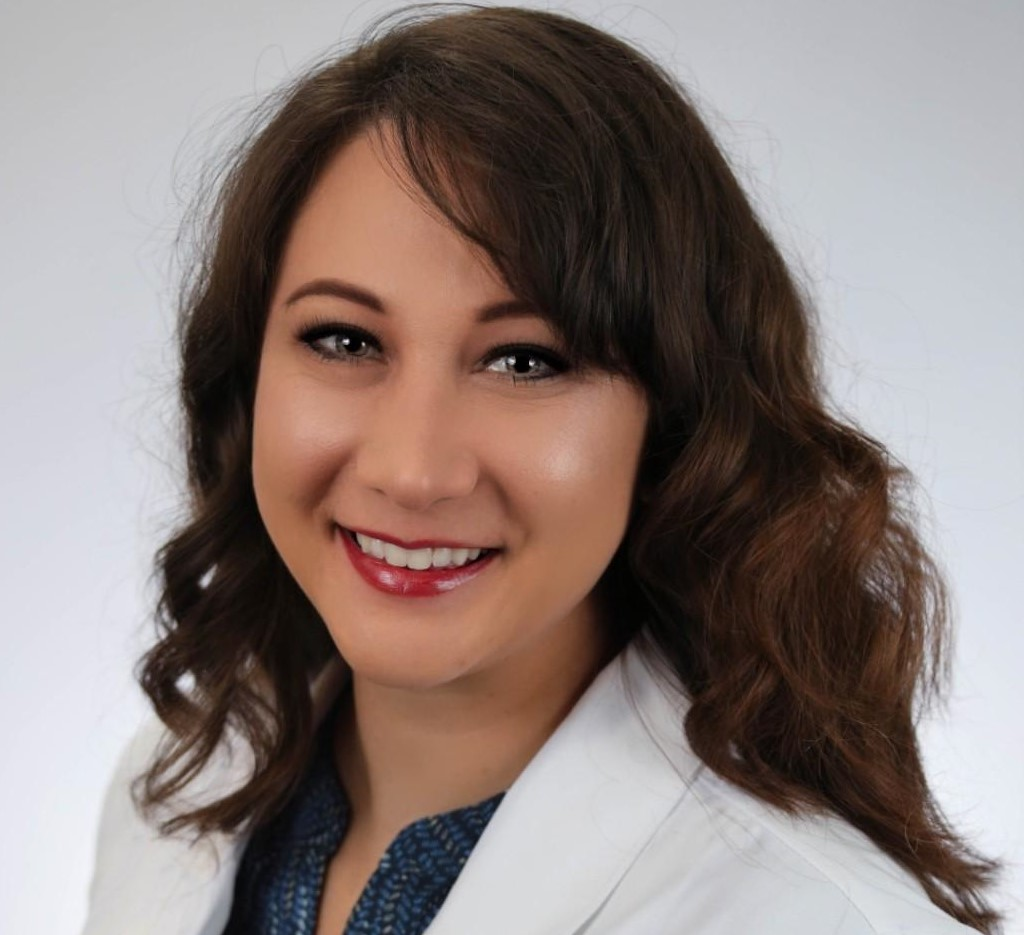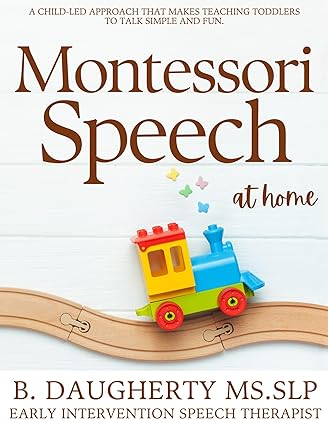“Like setting up a physical Montessori environment, I want to help parents build words into routines, like leaving Easter eggs for the child to collect and find.”

Author Briona Daugherty, MS SLP, chats with the Post about her work and newest publication, Montessori Speech at Home.
What is your educational and professional background? I have a master’s degree in Speech and Language Pathology from the University of Saint Augustine for Health Sciences. I work with children in early intervention speech and swallowing therapy from birth to 3 years of age outside Waco, Texas but am originally from San Diego, California.
What led you to study speech therapy? In undergrad, I studied musical theater and opera performance at San Diego State University. I spent 10 years working as a vocalist and entertainer for companies such as Royal Caribbean, Celebrity, Princess, Azamara, Hapag-Lloyd, and Crystal Cruise Lines. I entered the realm of speech pathology because I was interested in treating professional vocalists and vocal injuries. However, during graduate school, I fell in love with pediatrics after working at a school for kids with autism. At first, I was afraid of the diagnosis. I didn’t understand how to interact and help these children. But by following their lead and observing, they showed me what they needed. I loved seeing their growth and felt like speech therapy was my calling.
What led you to write Montessori Speech at Home? Most parents I see in evaluations have children between the ages of 14-24 months. These children have 3-5 words and struggle to use language as a tool. In a lot of these cases, the child does not actually need full-blown speech therapy. The parent just needs a little help promoting words in a way that helps kids learn to speak independently. Like setting up a physical Montessori environment, I want to help parents build words into routines, like leaving Easter eggs for the child to collect and find.
At no point do we opt for the traditional method of “listen to me, then repeat this word”; in fact, there’s a whole chapter I call the “say mama” loop and how to get out of it if you find yourself trapped. When we make direct requests of the child to speak, we not only take away opportunities for the child to learn to speak with independence, but we also teach them that words are a way adults control us. It’s not fun. They’re not the leader and they want to feel capable and competent. When we build words into routines and allow the child to decide when to speak, we promote not only independence and the fun factor. Sounds are fun. Words can be fun. Fun and Play is the key. Independence and freedom (within structure) is not the long way around. In my experience, it gets kids where they need to go faster.
What led you to Montessori? I realized that what I was doing, especially for children on the autism spectrum, was child-led and it was downright effective. When we saw direct teaching, such as “say mama,” I would get kids who literally refused to speak, or speak only when the parent requested it. It didn’t promote independence and trapped parents into making more direct requests. Montessori believed in her findings: that children are natural, eager learners. They were excited to learn about the culture of the family and belong in social activities when they were treated with respect and given the appropriate supports for education based on observation.
What did you learn along the way of writing Montessori Speech at Home? The concept that transformed my treatment approach the most was the Zone of Proximal Development. This concept suggests that children are naturally driven to solve challenges they find interesting. It wasn’t Montessori’s theory, but the theory aligns with much of how Montessori’s scaffolding (helping children grow from one step to the next) works. It also suggests why freedom within structure is also so effective as well. The theory originated by Lev Vygotsky, a Soviet psychologist who was a contemporary of Dr. Montessori with his work published in the early 1900s and posthumously in the later 1930s as well. The two researchers shared many similar beliefs on the importance of social and cultural context in terms of child learning.
The Theory is simple: If you were playing a video game and always won, you wouldn’t continue playing the game. Why? Because it would become boring. As humans, we seek challenges and gain confidence and enjoyment in mastering new skills. We want achievable challenges. If it’s too hard, and it’s outside the zone it’s not fun. Too easy it’s also outside the zone. If it’s achievable with a little problem solving, it’s inside the zone. As we grow in skills our zone expands and we’re naturally drawn to the next step in learning.
In speech therapy, many parents were saying their child just didn’t want to participate. However, this concept helped explain that, indeed, they do but only if it’s in their zone of proximal development. Children enjoy making fun and interesting new sounds. Most babies babble on their own because it’s enjoyable. Seriously, they’ll do it all day. Super fun. They are eager to master words too as long as it’ s achievable.
When children use the “reach and grunt” it means, “I’m hungry,” “Daddy’s home,” or “Look, a bug,”. It’s a big step to learning “milk,” which means one thing. It makes no sense why we would give up a sound that means “everything” to using 100’s of single words that only mean one thing. It can feel overwhelming. Overwhelming means it’s outside our Zone of Proximal Development.
Learning more about the Zone of Proximal Development has clarified how our speech therapy strategies can motivate children towards independent speech. This includes simplifying the target word to “muh” instead of “milk,” encouraging the use of baby signs (How Baby Signs Work: chapter 6), increasing the “smile factor” (Target the Smile not the Word: Chapter 4) repeating the word 3-6 times while giving the item but not asking for a response (The Rule of 3: Chapter 5).
What surprised you during the research or writing process? Maria Montessori faced people doubting her dreams throughout her life. She was actively harassed in school. Her first placement was in pediatrics, as that was deemed more appropriate for a woman. It’s uncertain what her choice would have been had she been given other options. However, she didn’t back down.
She was told that children in the psychiatric ward couldn’t be taught and that they had no hope of a normal life. Her response was, “Hold my bag,” as she rolled up her sleeves and found a way.
She was an exceptionally intelligent woman, and instead of dictating what Montessori education should be step by step, she placed an incredible amount of trust in people to experiment with teaching methods, just as she placed trust in her students. She expected education to be approached with the focus of a scientist and constant experimentation and adaptation.
At first, I questioned if these two areas could really work together. Speech Therapy requires an adult to provide the vocal model. Montessori wants adults out of the way. How could they ever blend? But I feel that if Maria Montessori were here today, she would have been excited about the prospect of this new pedagogy. One born of research, observation and trust in the child’s natural ability and interest in learning.
What is next for you? I’m getting married in July. I’m very excited about that. We’ll be having a small wedding in Portland, Oregon with family. There are 3 swans at the venue which I’m terrified of. They’re kind of aggressive. I’m starting a private practice in Georgetown, Texas called Georgetown Speech Therapy. I’ve been applying to be able to take insurance from multiple carriers for over 2 months and it’s a… process. I’d also like to build out MontessoriSpeech.com and investigate making some video tutorials for parents.
In the literary world, I wrote a chapter about words for hitting and biting in Montessori Speech at Home because it’s a common side-effect of speech delay. It was a standout chapter and honestly got so much excitement from beta readers, I think it could make for a full book. I’d like to try. I think it could be very helpful to families who are struggling in that area.
Montessori Speech at Home has a book release of May 1st 2024 and will be available for retail on Amazon and Barnes and Nobel. See Daugherty’s other work and visit her website at MontessoriSpeech.com.

Leave a Reply